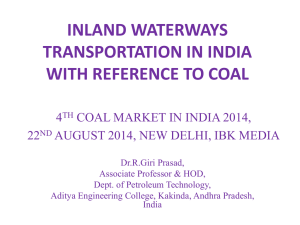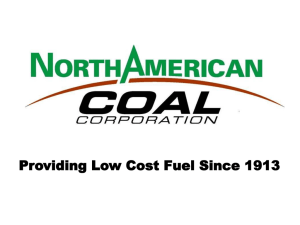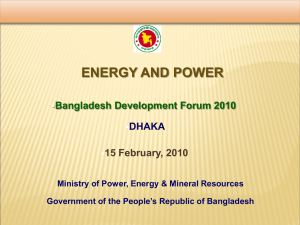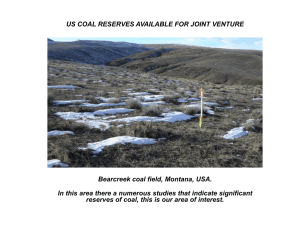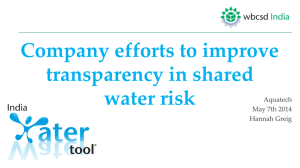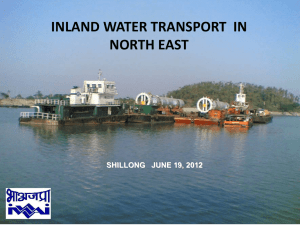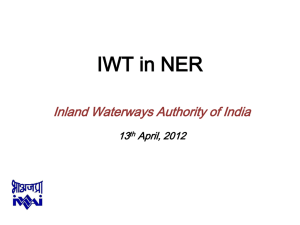event_8-6-1-5005877ba0a1f
advertisement
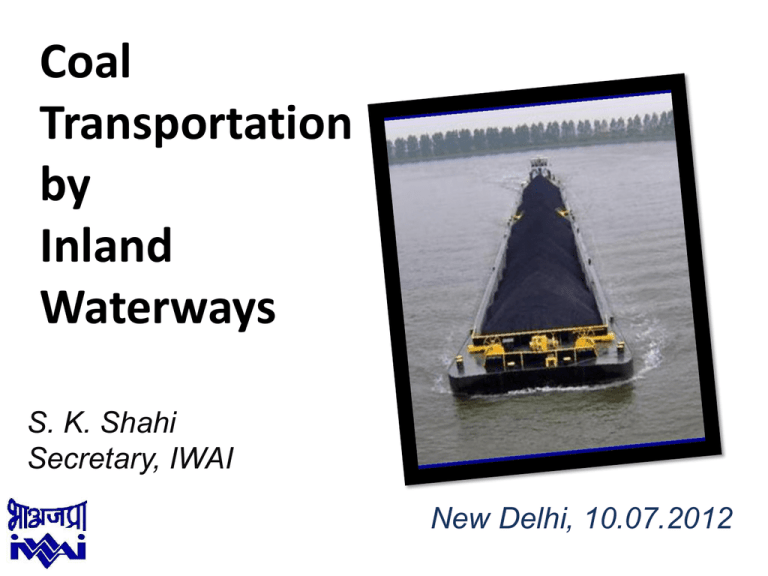
Coal Transportation by Inland Waterways S. K. Shahi Secretary, IWAI New Delhi, 10.07.2012 •1 IWT in the past IWT was important mode in the past • In 19th century steamers were plying from Kolkata up to Garhmukteshwar and Dibrugarh in the Ganga & Brahmaputra respectively • Development of Railways & Roads gave IWT a setback • In 1970s, IWT for NER revived with IWT&T Protocol between India & Bangladesh • In 1980s and 1990s, CIWTC used to ply vessels from Kolkata to Guwahati and Karimganj routes • Transported over 4 lakh tonne cargo in 1989-90, now engaged only in lighterage movement 2 IWT - Advantages Fuel efficiency: One HP moves Kgs 4000 3500 3000 2500 2000 1500 1000 500 0 4000 One liter of fuel moves (T-km) 105 120 85 Road 80 24 40 Rail 0 IWT Road Rail IWT Road 150 500 Rail 6 IWT 4 Operating cost (international level) Cents /T km 5.2 2.5 Road 1 2 0 Road Rail IWT Road Rail IWT Rail IWT 3 IWT – Advantages contd… Best suited for bulk cargo (coal, minerals, foodgrains, fertilizers, cement, flyash etc), ODC and hazardous goods Provides seaport - hinterland connectivity Less development & maintenance compared to Railways and Roads All weather mode of transport Can supplement Roads and Railways Strategic importance for North Eastern Region cost 4 Other advantages of IWT mode • Safest mode For each IWT fatality, there are 22.7 fatalities related to Rail and 155 in r/o Roads • Reduction of trucks from roads (decongestion) One 1000 tonne barge = 100 trucks • Corridor capacity While Road & Rail are stretched to limits, waterways in India have huge unutilised capacity 5 Other advantages of IWT mode • Most environment friendly Tons of CO2 per Million Tonmiles • Minimal land acquisition 6 Inland waterways & Coal transportation …….global scenario World's coal reserves South Africa Ukraine 4% Kazakhstan 4% Serbia 2% 4% Germany 5% United States 29% India 8% Coal is the largest commodity by volume moving on waterways –USA’s thermal power plants use waterways for > 20 % of coal –Germany: 45% Australia 10% China 14% Russia 20% –China: 17% –India: practically nil 7 Power Sector Overview Installed Capacity –Fuel wise Renewable Nuclear 3% Installed Capacity [GW] 2007 124 By 2012 190 By 2017 290 By 2022 425 By 2027 575 By 2032 800 10% Hydro 20% Diesel 1% Year Coal 54% Gas 10% Generation Installed Capacity (as on 31.12.2011) : 187 GW 8 Coal: demand - supply gap 800 • Power generation capacity: a critical 700 requirement • Coal: the main source 600 of energy 500 • Current coal demand: 400 696 MMT • May become 1000 300 MMT by 2017 • Estimated coal to be 200 imported : 137 MMT 100 696.03 656.31 597.98 550 573.42 535.23 559 497.29 COAL DEMAND(MMT) DOMESTIC (MMT) IMPORTED(MMT) 137.03 52.71 62.75 82.89 0 2008-09 2009-10 2010-11 2011-12 9 Need for import of thermal coal • Shortage of domestic coal • Growth of installed capacity > production of domestic coal; making import of coal inevitable • MoP has been directing generating companies for import of coal • CEA has also issued advisory for designing new boilers suitable for blending ratio of 30:70 (imported: domestic coal) or higher Hence, imported coal will play a key role in generating thermal power 10 Coal transportation bottlenecks • Railway Congestion • Shortage of rakes • Shortage of bottom opening wagons Railway network has its own limitations in terms of zonal capacities, inter-zone re-deployment of rakes, etc. • Port congestion • Low draft at some ports like Haldia Hence, overdependence on railways needs to be reduced: road is out of question : IWT a realistic supplementary option, especially for imported coal 11 Waterways of India • 14,500 km of potential waterways • Role of IWAI: Develop infrastructure and regulate movement on NWs • 3 NWs developed • Two more NW (4 & 5) declared in 2008 • One more NW declaration in process • Other waterways to be developed by States 12 13 14 TEJPUR NAGALAND SILGHAT P 31C I N D I JOGIGHOPA DHUBRI 31 ASSAM A PANDU DISPUR 37 P 37 36 INDO – BANGLADESH PROTOCOL ROUTES KOHIMA DAIKHAWA 31 40 SHISHUMARA SHILLONG 51 CHILMARI MEGHALAYA 53 BAHADURABAD 34 MANIPUR ZAKIGANJ SYLHET LAKHIPUR BHANGA KARIMGANJ MARKULI B A N G L A D E S H GODAGARI SIRAJGANJ RAJSHAHI P DHULIAN BAGHABARI BHAIRAB BAZAR ARICHA IMPHAL FENCHUGANJ SHERPUR AJMIRIGANJ 54 ASHUGANJ 44 TRIPURA DHAKA 53 P AKHAURA AGARTALA NARAYANGANJ N AIZWAL MIZORAM P Legend CHANDPUR 2 35 KOLKATA P 6 KHULNA BARISAL P CHALNA KAUKHALI P MONGLA 41 HALDIA ANGTIHARA P NAMKHANA Bay of Bengal Declared National waterway Proposed National waterway Protocol route Road Rail NH 51 Protocol route distances Kolkata - Guwahati/Pandu ...... 1535 km Kolkata - Karimganj...................1318 km Dhulian-Rajshahi...........................7815 km 15 KOTTAPURAM N National Waterway-3 17 West Coast Canal ALUVA (Kottapuram – Kollam) Champakkara & Udyogamandal canals UDYOGAMANDAL CANAL 49 KAKKANAD(CSEZ) CHAMPAKKARA CANAL MARADU KOCHI River distance Kottapuram - Kollam Udyogamandal canal Champakkara canal Total length 168 km 23 km 14 km 205 km VAIKOM 47 K CHERTHALA THANNERMUKKOM LOCK CUM BARRAGE E ALAPPUZHA 220 R A THRIKKUNNAPUZHA THRIKKUNNAPUZHA LOCK GATE L Arabian Sea KAYAMKULAM A CHAVARA KOLLAM Legend Waterway alignment Road Rail Important places 208 16 Development cost- Rs 1515 cr (2010prices) Notified on 25.11.2008 17 Development cost- Rs 4210 cr (2010 prices) Notified on 25.11.2008 18 Proposed National Waterway – 6 : River Barak Length –121 km Development cost -Rs 120 cr (at 2011 prices) Status: Declaration in process Bhanga Stretch Km Bhanga - Lakhipur 121 Badarpu r Silcha r 19 Inland waterways Advantage With so many waterways, their nonutilisation for transportation of coal is a great opportunity loss for the country 20 • Transportation of imported coal to hinterland TPS ideal for IWT Haldia to Farakka TPS; a success story in making • For domestic coal too Coastal Shipping & IWT movement possible for MCL coal Coastal vessel is Paradip/Dhamra Port loaded at • Lighterage at Haldia into IWT vessel for supplying coal to TPS on Ganga or Brahmaputra • Coastal vessel can directly supply coal at Budge Budge & Bandel TPS • With many thermal power plants located along Ganga and many steel plants near east coast there is tremendous scope for waterways for coal transportation 21 Thermal power plants along NW-1 Muzaffarpur 8 14 Barauni Buxar Allahabad 15 19 12 6 Kahalgaon 13 Bhagalpur9 Barh 11 10 18 Bara Karchana 16 17 Anapara Obra 8 THANK YOU Lakhisarai 7 Pirpainti 6 5 Farakka Installed power: around 15,000 MW 20 Total coal requirement: around 75 MMTPA Imported coal: around 15 MMTPASagardighi NTPC Plants State Govt Plants Proposed Power Plants Bandel Expansion 3 Budge Budge 2 Kolaghat 8 4 1 Haldia 22 Coal transportation by inland waterways from Bay of Bengal to Farakka TPS: a success story in making 23 • NTPC’s TPS at Farakka & Kahalgaon face acute shortage of coal • They require 3-4 MMT of imported coal • But due to several reasons, transportation of this coal has been a difficult and costly proposition for NTPC Draft constraint at Haldia: Available draft-7.0 m High waiting time at Paradip port Limited rake availability for transportation from port High Logistics cost leads to high delivered cost of coal Handling/ transition losses Delayed delivery leading to additional losses 24 After sustained persuasion by IWAI, NTPC gave commitment for transportation of 3 MMTPA imported coal by IWT for these plants for 7 years IWAI & NTPC developed a project with entire funding by private sector Project comprises of: Transhipment equipment at sea; about 40 barges; a terminal at Farakka; and coal conveyors from terminal to coal stack yard at Farakka Approximate cost: Rs 650 crore By open tendering Jindal ITF identified as L1 bidder Tripartite agreement signed among IWAI, NTPC & Jindal ITF on 11.8.11 Supply of coal to start in December, 2012 This could be a path breaking project for IWT in India 25 Support provided by IWAI/NTPC • Guaranteed cargo by NTPC- 3 MMTPA for 7 years • Assurance from IWAI to provide LAD OF 2.5 Mts. between Haldia- Farakka for at least 330 days in a year – Suitable for 1500 T – 2000 T barges • • • • Vertical clearance of 10 Mts. Assured night navigation facility Connectivity through DGPS stations Facilitation of transfer of land at Farakka for terminal 26 Current Status of Coal Transportation Project • M/s JITF finalized the contract for transshiper in March, 2012. • Trial run of barges undertaken successfully. • Orders place for barges at different shipyards. • Work for construction of Jetty at Farakka commenced. • Movement to start by December, 2012. JITF PROPOSED SOLUTION Transshipper at high sea Barges on NW-1 Destination : Jetty with grab unloaders at destination 28 Logistics Solution for Coal Transportation on Haldia - Farakka stretch Conveyer Belt NTPC Plant, Farakka Vessel types River Barge Tug and Dumb Barge Estuarine Ship Pushboat and Dumb Barges 30 Conclusion • IWAI is geared to provide assured navigation channel with night navigation aids in three operational NWs • With 10-11 TPS already in the vicinity of NW-1 and 10 more coming up; it will be unfortunate if we still do not use IWT for coal transportation thereon • Railways can simply not meet this demand- if waterways are not used, power generation will suffer- there is no other way • Haldia- Farakka coal transportation project can therefore be a trailblazer • Key to this project was long term cargo assurance by NTPC • Success of this project is being keenly awaited With long term cargo commitment from shippers; and assured waterway from IWAI; private sector will come forward to invest in vessels and even infrastructure on case to case basis 31 Thank you 32
